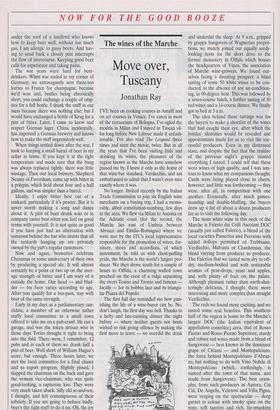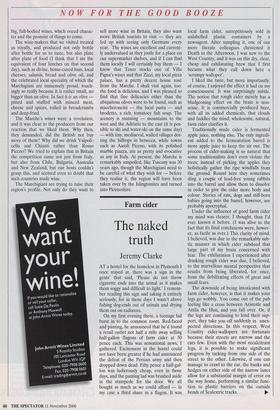The wines of the Marche
Move over, Tuscany
Jonathan Ray
I'VE been on cooking courses in Amalfi and on art courses in Venice, I've eaten in most of the restaurants of Bologna, I've ogled the models in Milan and I stayed in Tuscan vil- las long before New Labour made it unfash- ionable. I've also read The Leopard three times and seen the movie, twice. But in all the years that I've been visiting Italy and drinking its wines, the pleasures of the region known as the Marche have somehow passed me by. I knew it only as the home of that wine-bar standard, Verdicchio, and am embarrassed to admit that I wasn't even sure exactly where it was.
No longer. Invited recently by the Italian Trade Commission to join six English wine merchants on a buying trip, I had a memo- rable, albeit constitution-numbing, few days in the area. We flew via Milan to Ancona on the Adriatic coast (for the record, the Marche lies east of Umbria between Abruzzi and Emilia–Romagna) where we were met by the ITC's local representative responsible for the promotion of wines, fur- niture, shoes and accordions, of which instrument, he told us with chest-puffing pride, the Marche is the world's largest pro- ducer. We then drove south for a couple of hours to Offida, a charming walled town perched on the crest of a ridge separating the rivers Tesino and Tronto and famous locally — for its bobbin lace and its triangu- lar Piazza del Popolo.
The first full day reminded me how pun- ishing the life of a wine-buyer can be. No, don't laugh, the first day was hell. Thanks to a hefty and late-running dinner the night before — where neither guests nor hosts wished to risk giving offence by making the first move to leave — we overdid the drink and underdid the sleep. At 9 a.m., gripped by grappa hangovers of Wagnerian propor- tions, we mutely joined our equally seedy- looking hosts for the short drive to the former monastery in Offida which houses the headquarters of Vinea, the association of Marche wine-growers. We found our- selves facing a daunting prospect: a blind tasting of some 50 white wines to be con- ducted, in the absence of any air-condition- ing, in 90-degree heat. This was followed by a seven-course lunch, a further tasting of 50 red wines and a 14-course dinner. We finally got to bed at 3 a.m.
The idea behind these tastings was for the buyers to make a shortlist of the wines that had caught their eye, after which the bottles' identities would be revealed and appointments made for us to visit the suc- cessful producers. Even in my distressed state, and despite the fact that the residue of the previous night's grappa tainted everything I tasted, I could tell that these were wines of high quality, and I was anx- ious to know what my companions thought. Cards were being played close to chests, however, and little was forthcoming — they were, after all, in competition with one another. Eventually, after much games- manship and double-bluffing, the buyers drew up a list of about a dozen producers for us to visit the following day.
The main white wine in this neck of the Marche is Falerio dei Colli Ascolani DOC (usually just called Falerio), a blend of the local varieties Passerina and Pecorino with added dollops permitted of Trebbiano, Verdicchio, Malvasia or Chardonnay, the blend varying from producer to producer. The Falerios that we tasted were dry to off- dry, medium-bodied and with noticeable aromas of pear-drops, yeast and apples, and with plenty of fruit on the palate. Although pleasant rather than earth-shat- teringly delicious, I thought them more interesting and more complex than straight Verdicchio.
The reds we found more exciting, and we tasted some real beauties. This southern half of the region is home to the Marche's largest DOC (the Italian equivalent of appellation controlee) area, that of Rosso Piceno and Rosso Piceno Superiore, sturdy and robust red wines made from a blend of Sangiovese — best known as the dominant grape of Chianti — and Montepulciano, the force behind Montepulciano d'Abruz- zo, but nothing to do with Vino Nobile di Montepulciano (which, confusingly, is named after the town of that name, and made from Sangiovese). The best exam- ples, from such producers as Aurora, Cif'. Chi, De Angelis, Velenosi and Villa Pigna, were verging on the spectacular — deep garnet in colour with smoky spice on the nose, soft tannins and rich, lip-smacking
NOW FOR THE GOOD BOOZE
big, full-bodied wines, which oozed charac- ter and the promise of things to come.
The wine-makers that we visited treated us royally, and produced not only bottle after bottle for us to taste, but also plate after plate of food (I think that I ate the equivalent of four lunches on that second day), such as divine, home-cured ham, local cheeses, salamis, bread and olive oil, and the celebrated local speciality of which the Marchigiani are immensely proud, touch- ingly so really because it is rather small, no bigger than an olive. In fact it is an olive pitted and stuffed with minced meat, cheese and spices, rolled in breadcrumbs and deep-fried.
The Marche's wines were a revelation, and it was clear to the producers from our reaction that we liked them. Why then, they demanded, did the British not buy more of them? Why did we drink Valpoli- cella and Chianti rather than Rosso Piceno? We tried to explain that in Britain the competition came not just from Italy, but also from Chile, Bulgaria, Australia and New Zealand, but our hosts couldn't grasp this, and seemed even to doubt that such countries made wine.
The Marchigiani are trying to raise their region's profile. Not only do they want to sell more wine in Britain, they also want more British tourists to visit — they are fed up with seeing only Germans every year. The wines are excellent and current- ly undervalued as they jostle for a place on our supermarket shelves, and if I can find them locally I will certainly buy them — I know that Tesco stocks one of Villa Pigna's wines and that Zizzi, my local pizza palace, has a pretty decent house rosé from the Marche. I shall visit again, too: the food is delicious, and I was pleased to find that fine delicacies other than the ubiquitous olives were to be found, such as maccheroncini — the local pasta — and brodetto, a rich, tomatoey fish soup. The scenery is stunning — mountains to the west and the Adriatic to the east (it is pos- sible to ski and water-ski on the same day) — with tiny, mediaeval, walled villages dot- ting the hilltops in between, while towns such as Ascoli Piceno, with its polished marble piazza, are as pretty and evocative as any in. Italy. At present, the Marche is remarkably unspoiled, like Tuscany was 30 years ago, though the Marchigiani need to be careful of what they wish for — before they realise it, the region will have been taken over by the Islingtonites and turned into Picenoshire.



























































































 Previous page
Previous page